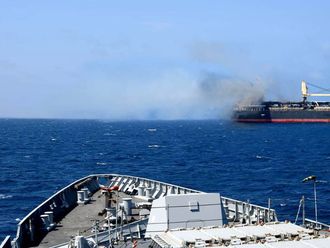In Najran, the thump of artillery reverberates all day across a valley ringed by desert mountains along Saudi Arabia’s southern frontier with Yemen.
Security guards at an archaeological site outside the city barely register the blasts as Saudi land forces fire shells across the border. Like many in Najran, they’ve gotten used to the daily reality of a war that most Saudis only see on their TV screens, if at all.
For most of the nine-month conflict, the frontlines have been far south of the kingdom’s borders, around cities like Taiz and Aden, where the Saudis and their coalition partners pushed out Al Houthi militants seen as allies of Iran. On the Saudi side, it’s only in Najran — even if on a far smaller scale — that war is having a direct impact.
The city’s airport is closed, forcing residents to travel almost 300km to the nearest alternative. Schools open then shut again, depending on the fighting. Once-busy markets are empty. Across the border, swaths of Yemen have been heavily bombed, leaving thousands of civilian casualties and refugees.
Failed Talks
“None of the people in Najran like this war,” said Hassan Al Wadee, a 57-year-old man whose shop sells the curved Yemeni daggers known as jambiyas. “We want this war to end.”
Efforts to halt the fighting have made little progress. UN-brokered peace talks resumed this month but a cease-fire quickly broke down, like earlier attempts, with each side accusing the other of breaching it. Another round of talks is due to start on January 14 in Ethiopia.
On the highway between Najran and Abha, to the northwest, war spending is evident. Information Ministry employees point to dozens of new army encampments, built to stop Al Houthis from attacking border posts. Trucks pulling military vehicles crawl up the steep passes, as forces rotate along the frontier area.
Across the border in Yemen, local resident Mohammed Esmail says the Saudis are shelling almost every hour.
“The Al Houthis are responding with mortars,” he said by phone. “They sometimes carry out attacks inside Saudi territory but withdraw under heavy shelling and air strikes.”
Frankincense Trade
Najran is only a few kilometers from the border, and the other side is held by Al Houthis and tribes loyal to them. Skirmishes have occurred since the war began in March and are now routine.
Rockets fired by the militia regularly land in Najran’s centre
Southern Saudi Arabia offers “the charm of heritage, monuments and pristine nature,” according to tourist brochures. But hotels are empty and there were no visitors at the ancient city of Al Ukhdud, where frankincense traders once passed on their way from Yemen to Makkah, Madinah and the Levant.
The city, its population and its mud-brick architecture are as much Yemeni as Saudi. Local dress codes are different from Riyadh: the traditional white robe is less in evidence, and people wear jambiyas tucked in their belts. The staple food is Yemeni, too: Aseed, a dumpling-like dish made from flour and spices.
At his shop, Al Wadee said he hopes the Saudis win the war, defeating what he says is Iranian aggression across the border.












